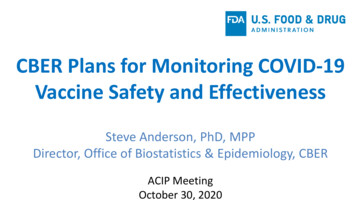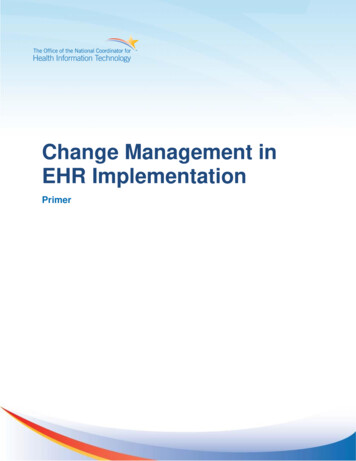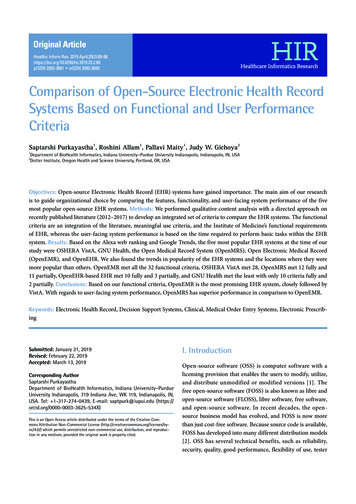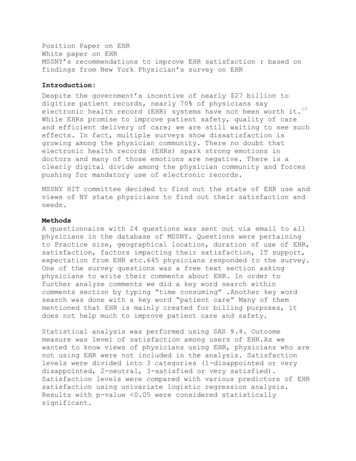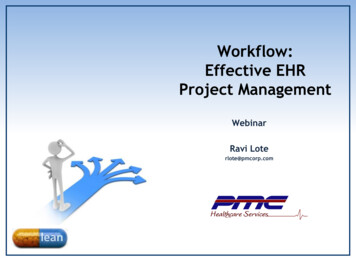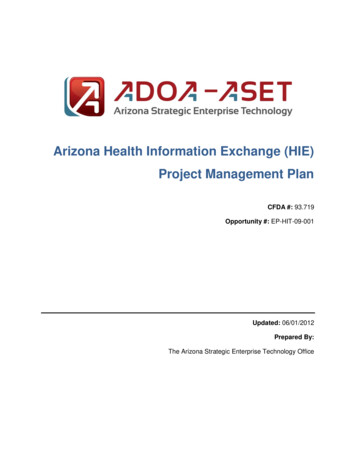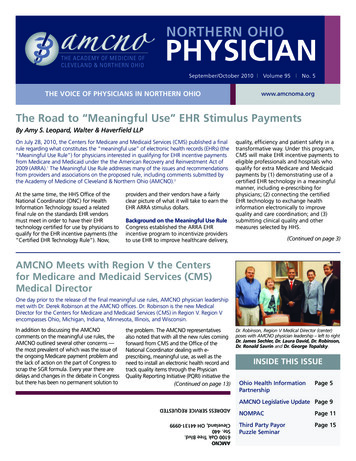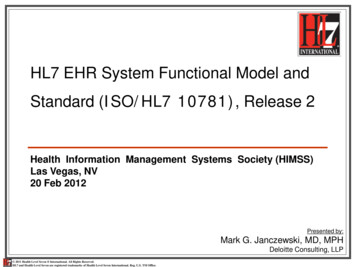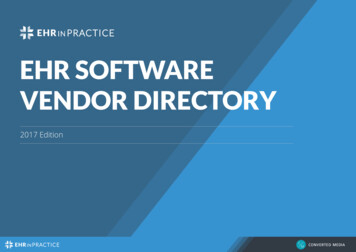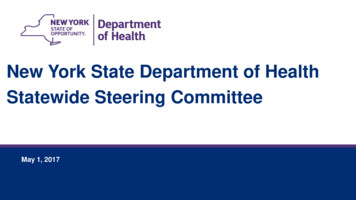
Transcription
Change Management inEHR ImplementationPrimerProvided By:The National Learning Consortium (NLC)Developed By:Health Information Technology Research Center (HITRC)The material in this document was developed by Regional Extension Center staff in the performance oftechnical support and EHR implementation. The information in this document is not intended to serve aslegal advice nor should it substitute for legal counsel. Users are encouraged to seek additional detailedtechnical guidance to supplement the information contained within. The REC staff developed thesematerials based on the technology and law that were in place at the time this document was developed.Therefore, advances in technology and/or changes to the law subsequent to that date may not have beenincorporated into this material.April 30, 2013 Version 1.0
NATIONAL LEARNING CONSORTIUMThe National Learning Consortium (NLC) is a virtual and evolving body of knowledge andresources designed to support healthcare providers and health IT professionals working towards theimplementation, adoption and meaningful use of certified EHR systems.The NLC represents the collective EHR implementation experiences and knowledge gained directly fromthe field of ONC’s outreach programs (REC, Beacon, State HIE) and through the Health InformationTechnology Research Center (HITRC) Communities of Practice (CoPs).The following resource can be used in support of the EHR Implementation Lifecycle. It is recommendedby “boots-on-the-ground” professionals for use by others who have made the commitment to implementor upgrade to certified EHR systems.EHR Implementation LifecycleDESCRIPTION & INSTRUCTIONSThis primer is intended to aid providers and health IT implementers with Change Management for EHRImplementation. Change management is the basic foundation underlying all phases of the EHRimplementation lifecycle and helps achieve EHR Meaningful Use and practice transformation. The EHRImplementation Lifecycle shows the phases a practice goes through in a successful implementation.Change management strategies and principles must be integrated into all phases of the implementationprocess. This Change Management Primer synthesizes the strategies and principles proposed by JohnKotter, one of the leading experts in planning organizational change using a structured changemanagement approach.This resource includes the following sections: Section 1 introduces the basic change management principles and explains why managing anychange effectively is important to the success of EHR implementation and other practicetransformation initiatives.Section 2 provides more detail on implementing Kotter’s principles in practice settings that arefocused on managing specific organizational changes commonly seen in practices today. Thediscussion focuses on ways to help practice leaders optimize the use of health information technology(health IT) to move their practice to a desired Future State.April 30, 2013 Version 1.0i
Section 3 provides a summary of critical success factors and the management interventions that mustoccur to achieve success with change initiatives and some “must do” steps to effectively managechange.Section 4 provides additional resources related to change management.April 30, 2013 Version 1.0ii
TABLE OF CONTENTS1What Is Change Management and Why Is It Important? . 11.1 Introduction . 11.1.1 Phase 1, Creating a Climate for Change . 21.1.2 Phase 2, Engaging and Enabling the Organization . 31.1.3 Phase 3, Implementing and Sustaining the Changes . 31.2 How Will Change Impact People, Processes, and Technology? . 41.2.1 Changing How People Work . 41.2.2 Changing Processes . 41.2.3 Changing the Technology . 52What Steps Do I Need to Take to Get Started? . 62.1 Paper to EHR . 62.1.1 Action Steps for Phase 1: Creating a Climate for Change . 62.1.2 Action Steps for Phase 2: Engaging and Enabling the Organization . 72.1.3 Action Steps for Phase 3: Implementing and Sustaining the Changes . 72.2 Moving from Stage 1 to Stage 2 Meaningful Use—Patient Engagement . 92.2.1 Action Steps for Phase 1: Creating a Climate for Change . 92.2.2 Action Steps for Phase 2: Engaging and Enabling the Organization . 92.2.3 Action Steps for Phase 3: Implementing and Sustaining the Changes . 102.3 Replacing an Existing EHR (Rip and Replace) . 122.3.1 Action Steps for Phase 1: Creating a Climate for Change . 122.3.2 Action Steps for Phase 2: Engaging and Enabling the Organization . 122.3.3 Action Steps for Phase 2: Implementing and Sustaining the Changes . 122.4 New Models of Care—Patient-Centered Medical Home . 152.4.1 Action Steps for Phase 1: Creating a Climate for Change . 152.4.2 Action Steps for Phase 2: Engaging and Enabling the Organization . 162.4.3 Action Steps for Phase 3: Implementing and Sustaining the Changes . 163Measuring the Effectiveness of Your Change Management Strategies to Enhance Success. 184Resources . 21April 30, 2013 Version 1.0iii
LIST OF EXHIBITSExhibit 1 Kotter's Three-Phased Approach to Managing Change . 1Exhibit 2: Overview of the Three Phases of Kotter’s Change Management Principles and RelatedActions for Paper to EHR . 8Exhibit 3: Overview of the Three Phases of Kotter’s Change Management Model and RelatedActions for MU1 to MU2: . 11Exhibit 4: Overview of the Three Phases of Kotter’s Change Management Model and RelatedActions for Upgrade/Rip and Replace . 14Exhibit 5: Care Coordination and Health IT . 15Exhibit 6: Overview of the Three Phases of Kotter’s Change Management Model and RelatedActions for PCMH Recognition . 17Exhibit 7: Managing Change Through Active Practice Leader Intervention . 18Exhibit 8: Critical Success Factors and Management Interventions for Managing Change . 19April 30, 2013 Version 1.0iv
1 What Is Change Management and Why Is ItImportant?1.1INTRODUCTIONChange management is “the application of the set of tools, processes, skills and principles formanaging the people side of change to achieve the required outcomes of a change project orinitiative.”The Change Management Learning CenterChange in health care is moving at a rapid pace as practices strive to implement regulatory and policyrequirements, such as ICD10; understand new models of care such as Patient-Centered Medical Homes(PCMHs); and continue their own quality improvement efforts. Many practices are doing all of this whileimplementing a certified electronic health record technology (CEHRT) to achieve Meaningful Use. Thischange is happening at a time when providers are still seeing patients and trying to maintain a healthywork life balance.These are clearly stressful times for providers and their staff, and adapting to change has become a wayof life for their practices. Fortunately, change management is a well-developed field with significantevidence and leading practices on how to successfully navigate the change process. One of the leadingthinkers in planning organizational change and providing practical strategies for navigating change isJohn Kotter.Kotter believes that any change has both emotional and situational components, and he has proposed amulti-step change model. The model is organized into three phases to help leaders manage thechallenges that are inherent in any change initiative (Campbell, 2008). Exhibit 1 illustrates how Kotter’sthree-phased approach can be used when planning a change from the current way of doing business andcaring for patients to the vision you have for your future practice, one that optimizes the use of technologyto provide safe, high-quality, and efficient patient care services while meeting regulatory requirements.Exhibit 1 Kotter's Three-Phased Approach to Managing ChangeAs illustrated, Kotter’s Change Management Model points to the need to think of the change process as ajourney for the entire organization. The journey will be smoother if everyone understands: Why they need to leave the Current StateApril 30, 2013 Version 1.01
Why the Future State is better for their patients and the practiceWhat changes in workflows will be necessaryWhat technologies and new skills will be requiredHow staff will learn those new skills and gain knowledge of how the technology fits into their everydaywork life.The following section is a brief overview of the three phases of Kotter’s Change Management Model andthe management focus required during each phase.1.1.1 Phase 1, Creating a Climate for ChangeIn this phase, practice leaders must create a climate for change by accomplishing the following: Establishing a sense of urgency What could be improved from our Current State? What is better about the Future State? Why do we have to change NOW? Building a guiding coalition Who are the natural leaders (champions) for this change initiative? What team building is needed to form a cohesive team?Creating a vision for the Future State What will life be like in the Future State for our patients? For our staff? For me? Urgency in some practices may be driven by the desire to modernize the practice using CEHRT. Otherpractices may be driven to more comprehensive care delivery models such as PCMH or participation in alocal accountable care organization (ACO). Whatever the reason prompting the change, the practiceleaders must help all staff understand why the change needs to occur.At this point in the planning, it is important to identify the key staff who will help lead the initiative. Kottercalls this coalition the “guiding team.” So, which practice staff should be a member of your guiding team?As the practice leader, you should choose staff who: Fully understand the goals and vision for the Future State and are eager to help the practice reachthose goals Are able to interpret the why, the how, and the urgency, and then communicate that clearly to allpractice staff Are knowledgeable of practice operations, work flow, and processesAre “people oriented” and recognize the individual strengths of each team member and how each canbe useful in all phases of the change implementationThe knowledge base, coupled with the necessary people management skills, will help the guiding teamestablish credibility among their peers. These skills will be needed throughout all the phases to addressboth the emotional and situational challenges that will occur throughout the change process.Creating a clear vision for what the Future State should look like for the practice is one of the most criticalsteps in this phase. Even when the Current State is inefficient or problematic, staff are comfortable withthe known and are fearful of the unknown. The clarity of the vision will provide much-needed emotionalApril 30, 2013 Version 1.02
support as the practice goes through the next two stages of changing their process and updating theirskills to make the Future State a reality.Think of the Future State as a destination postcard and your change management plan as a roadmap.The journey is much easier when we routinely remind ourselves what the destination looks like and havea map for how to get there.1.1.2 Phase 2, Engaging and Enabling the OrganizationIn this phase, the practice leader and guiding team need to design implementation strategies that willengage all levels of the organization in the change process. Specifically, the practice leaders need toachieve the following: Communicate the Future State – Think of innovative ways,such as, the use of vendordemonstrations, videos, role-playing, or simulated Question/Answer (Q/A) communication techniquesthat match the practice culture. Alternatively, have your staff visit practices that have had successfulCEHRT implementations.Empower others to take action toward accomplishing the Future State – Ensure that staff have aclear understanding of the authority you are giving them. One of the most effective means ofempowering staff is to include them in the vendor selection process, particularly if the practice isconsidering a change in vendors. Another effective means of empowering staff is to delegateleadership roles for training scheduling and workflow redesign.Plan for and create short-term wins – Recognize high levels of achievement and promote goodideas. Clearly, the “go-live” event is a big win for the practice as well as successfully attesting toMeaningful Use. Other wins include attaining practice goals for patient quality improvements.Setting up communication channels and establishing communication strategies are critical during thisphase. Staff may feel threatened by the change and want to know how the change will affect their jobboth today and in the future. The guiding team should turn these concerns into opportunities for pilotteams to investigate how to overcome perceived and real obstacles.A key lesson from the field: Listen to your staff—they are the experts in the operational nuancesin your practice setting. They may know what is causing the most problems for the practice and haveideas for fixing the problems. Leverage the staff’s knowledge, expertise, and experience, and foster theirideas for how the change can be best implemented. Enable their participation in the design,implementation, and evaluation of the progress of the initiative. When things go wrong, empower staff tofind solutions and acknowledge the individual’s contributions to workable solutions. Encourage other staffto do the same. The practice leader can also keep a pulse on what’s working well and what is not—theycan reinforce and reward the former and work with the staff to find solutions for the latter.1.1.3 Phase 3, Implementing and Sustaining the ChangesThe last phase focuses on the need for continued monitoring and intervention by the guiding team. Thebottom line: do not stop—do not give up. The goal is to ensure that the change endures. In this phase,the guiding team: Continues to focus on problem areas, promotes solutions, and help change individual behavior toachieve organizational goalsPrepares to train, retrain, and provides technical assistance to rapidly address problemsCelebrates the successes as often as they can. People like to know when they are winning. Individualbehavioral changes will eventually result in a change in the organization’s culture that aligns with theFuture State.April 30, 2013 Version 1.03
While Kotter’s model is not a linear, step-by-step approach to change management, it is an iterativemodel. Thus, accomplishing one step can be helpful in accomplishing another step.As with all management initiatives, the most important element is planning. The person responsible forplanning, implementing, and evaluating change within an organization must recognize why individualsand organizations resist change and plan for the change, taking into consideration how the change willimpact people, processes, and technology.1.2HOW WILL CHANGE IMPACT PEOPLE, PROCESSES, ANDTECHNOLOGY?A successful implementation of a CEHRT, or new models of care, can be used as a catalyst to promotepractice transformation and to achieve the organizational culture changes needed to attain and sustainthe practice’s vision for their Future State. Planning for changes in how people work, the processes theyuse, and how technology can be used to help them work more efficiently and effectively is the key toachieving the vision for a new Future State. For a change initiative to be successful, systems andprocesses must align with technological changes. Health IT, for example, does not simply automateexisting paper processes; it is a tool used to integrate systems and processes to transform practices. Aneffective change strategy can be used to communicate the benefits of the changes in how people workand the processes they use and how this will help the organization achieve the desired Future State.1.2.1 Changing How People WorkAchieving EHR Meaningful Use or implementing new models of care will change how people in theorganization do their work. Managing the people dimension of organizational change is critical toachieving success for any change initiative because changing how people work together can alterorganizational culture (Leape & Berwick, 2005). Research and reviews of failed change initiatives showthat failure occurred because the initiatives did not deal with changes in how people and organizationswork; the EHR technologies themselves did not lead to failure (Kaplan & Harris-Salamone, 2009). Basedon these documented lessons learned, practice leaders must consider several people-related factorswhen facilitating change for their staff: Change creates uncertainty – Even when the Current State is not ideal, change can upset theequilibrium of both individuals and organizations. People are afraid of loss – Fear of loss can include job loss, loss of social position in the group,and/or loss of self-esteem related to fear of being unable to use the technology or adequately care forpatients using the technology. Team pressure to resist change is powerful – Staff members may feel that tensions associatedwith change and the social price for cooperating with the change are too great to accept the change. Staff may believe that proposed change is not in their best interest and/or that of the practice– If staff believe the change harms them or the practice, they will resist it, especially if they have hador even heard about negative experiences with other organizational changes or health ITimplementations.One remedy for overcoming these people issues is to keep staff at all levels involved in the planning,implementation, and evaluation of all change initiatives.1.2.2 Changing ProcessesJust as people may have to change their work requirements to accommodate attaining EHR MeaningfulUse or successfully implementing new models of care, changes to existing clinical and businessApril 30, 2013 Version 1.04
processes and practices, the rules governing the practice, and organizational structures and workrelationships in the practice must be assessed and changed as needed. Key points to consider are: All staff in the practice must be involved in assessing policies, procedures, and workflows. Practice leaders should be prepared to pilot process changes and make adjustments as needed.Again, rely on your staff for the best solutions! Innovative solutions should be rewarded and continuous quality improvement should be encouragedto make the changes even better.Staff members should be the ones to implement changes in these areas as a result of theassessment because they are the experts on what is not working in the Current State and can makerecommendations for using the technology to move the practice to the desired outcome and FutureState.1.2.3 Changing the Technology 1Whether you are implementing a new EHR or replacing an existing EHR to help your practice move fromStage 1 Meaningful Use (MU1) to Stage 2 Meaningful Use (MU2), or implementing new models of care,both internal and external forces serve as catalysts for achieving success. Internal forces include thedesire to achieve the Future State, such as, providing better care for patients or improving the efficiencyand effectiveness of the organization. External forces could include regulatory or policy changes, fundingchanges, or changes in the competitive landscape of a particular practice. Depending on the organization,technology can be used to address both the internal and external forces that impact practices. Justremember that changes in the technology platform involve technological changes throughout theorganization and will result in the need to change policies, procedures, and processes, and in the need toretrain employees.In summary, practice leaders, who are often champions of the change, must communicate that theyunderstand the practice environment and needs, the new technology and how it will impact both patientsand the practice, and, more important, how change and transformation will impact each staff member’sday-to-day job. The points and principles of the change can then be tailored so that transforming thepractice through technology and associated updates in clinical and business processes is a positiveexperience.This first section of the Primer has presented a conceptual framework for managing change, highlightingthe importance of why using a structured change management approach can impact the success of anychange initiative. Section 2 addresses the specific steps for implementing, evaluating the effectiveness of,and structuring a Change Management Plan tailored for: (1) implementing a new EHR, (2) helpingproviders move from Stage 1 Meaningful Use to Stage 2 Meaningful Use, (3) replacing or upgrading anexisting EHR, and (4) implementing new models of care, such as PCMH. Section 3 provides tips andstrategies for management, evaluation, and oversight of critical success factors and lessons learnedrelated to what works and what does not.1Additional information on the Kotter Change Management Model and the model principles and steps may be foundat changesteps/changesteps.More information about the stages of healthIT-enabled transformation of medical organizations (PracticeTransformation) can be found on HealthIT.gov, r-implementationsteps.April 30, 2013 Version 1.05
2 What Steps Do I Need to Take to Get Started?Kotter’s change management principles can be used to guide the planning and action steps that willfacilitate your change initiatives. The following are four health-IT-enabled change initiatives that may berelevant for practices: Paper to EHR – With the advancement of Meaningful Use and the increased adoption of EHR use,many practices are no longer making the initial transition from paper to EHR; however, they may beimplementing other healthIT-enabled change initiatives that will improve care. Stage 1 to Stage 2 Meaningful Use – When practices move to Stage 2 Meaningful Use, enhancedpatient engagement becomes a focus for many. System Replacement (Rip and Replace) – For early adopters of EHRs, many practices may bereplacing legacy systems to better position themselves for new payment models or other innovativeapproaches to improved patient care and more efficient practice operations. Patient-Centered Medical Home Model of Care – New models of care have been endorsed with thepassage of the Affordable Care Act, specifically, the PCMH model of care.Each of these change initiatives can be viewed as a desired Future State of a practice. Health IT can beused as a key driver within each of these change initiatives. The following sections detail specific actionsteps, based on Kotter’s change management principles, which will aid practices in these changeinitiatives.2.1PAPER TO EHRSelecting an EHR vendor for the practice is an integral piece of the EHR lifecycle and requires asignificant investment of dollars, resources, and time. Experience has shown some practices spend atleast a year investigating vendors. The importance of this phase cannot be understated. Matching theappropriate vendor to the practice and its needs can ease the transition during practice transformation.The relationship between a vendor and a practice can be long-lasting, and aspects of the relationship caninfluence the practice for years to come. Leaders can use the following action steps to promotesuccessful change in the practice setting:2.1.1 Action Steps for Phase 1: Creating a Climate for Change Create a Future State (vision). Communicate the Future State, priorities, and goals of the EHRimplementation. Hold meetings, develop documentation, and communicate in various ways sostakeholders understand the Future State. Soliciting and using input from interdisciplinary sourcescan be a cultural change for many small practices (that traditionally have not sought interdisciplinaryinput in their decision making). Such input can come from patients, physicians, nurses, other clinicalstaff, nonclinical staff, health system affiliates, and other affiliated practices.Identify a champion. Identify and cultivate a champion or multiple champions to lead the guidingteam. The champion(s) should be staff who is/are supportive of the change and can keep theimplementation process moving forward. A practice can have a single champion, such as a physicianor nurse leader, or a group of champions, including representatives from different user roles (e.g.,administrative staff, clinical staff). Champions are essential in the success of EHR implementation.Establish a project plan. Vendors often provide project plans that will cover the EHR implementationand training components of the project. However, the vendor-supplied project plans usually need tobe adapted to include all aspects of the project and the unique needs of a practice. The practice mustensure that the vendor plan meets its needs or is modified to accommodate them.April 30, 2013 Version 1.06
2.1.2 Action Steps for Phase 2: Engaging and Enabling the Organization Engage practice staff in all facets of system selection andA staff member from thepractice redesign/transformation. Engaging users throughout theMultnomah County Healthsystem selection and implementation process ensures that staffDepartment stated, “You cannothas ownership in the process. Involve practice staff in the creationsimply abandon a clinic after theof the EHR functional and technical requirements so they canfirst day. They need a lot ofcompare the practice’s clinical and business requirements with thesupport and training.”specifications of the EHR. Help users understand how the systemcapabilities will contribute to the transformation of the practice toachieve the Future State.Conduct trainings. Include ample time for training and implementation with staff. A transition period(with some problems) may occur; if problems persist, reeducation might be needed. If reeducationdoes not work, however, the change may need to be reevaluated.Evaluate usability. A usable system reduces error and user fatigue, has the necessary functionalityfor the practice, and promotes efficiency. A system that has poor usability requires greater trainingtime, can hinder productivity, may require extensive customization, and can contribute to user errorand fatigue (HIMSS EHR Usability Task Force, 2009).2.1.3 Action Steps for Phase 3: Implementing and Sustaining the Changes Update system based on feedback. By engaging staff inall phases of implementation, practice leaders can translatestaff feedback into system updates. By making smallchanges to the system to facilitate better workflows,practice leaders may help alleviate some of the burden onstaff.Reward staff. The people who have been instrumental inthe EHR implementation should be recognized andhonored. Practice leaders need to reassure people aboutthe changes that have been accomplished. Celebrationsbring people together in a relaxed and informal setting toacknowledge the success.Terry et al. (2006) captured a number ofongoing shifts in EHR functionality andrequirements to alleviate unexpectedburdens on physicians. Originally staffwere required to complete all fields inthe EHR. After a review to determinewhich fields were useful for clinical careand required for quality reporting, thenumber of fields requiring completionwas reduced significantly.Exhibit 2 shows a summary of Kotter’s action steps and relevant actions for this scenario.April 30, 2013 Version 1.07
Exhibit 2: Overview of the Three Phases of Kotter’s ChangeManagement Principles and Related Actions for Paper to EHRPhase 1 – Creating a Climate for ChangeKotter’s PrinciplesPaper to EHRCreating a vision for the Future StateCreate a Future State (vision) What wil
Change management is "the application of the set of tools, processes, skills and principles for managing the people side of change to achieve the required outcomes of a change project or initiative." The Change Management Learning Center. Change in health care is moving at a rapid pace as practices strive to implement regulatory and policy
